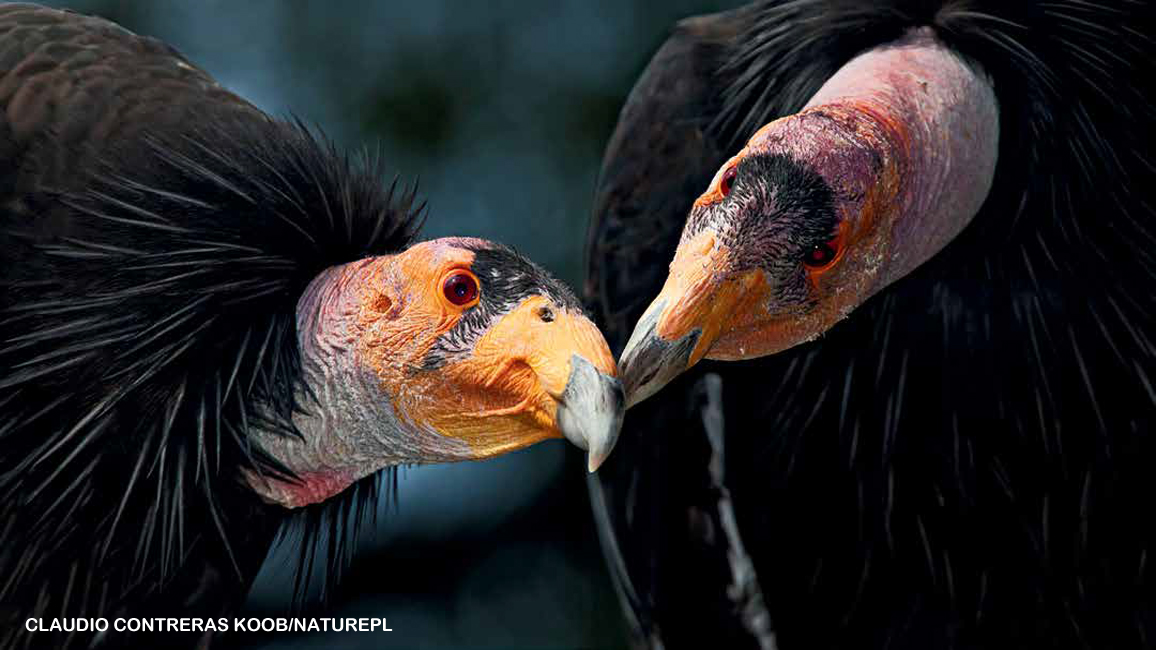
Bringing Back Condors
By Matt DesesnbergMembers of one Indigenous tribe are bringing these rare birds back home to northern California.

EARLY ONE MORNING in May 2022, a young California condor was beginning what would be a very interesting day. He crept toward the open door of an outdoor aviary, a large cage for birds. With a flap of his wings, he leaped into the air and flew off. Moments later, a second condor followed him out.
Nearby, Tiana Williams-Claussen was watching proudly. Tiana is a wildlife biologist and member of the Yurok Tribe. “I felt giddy, like a kid on Christmas morning,” says Tiana. “Watching them fly free was one of those moments that’s going to be with me forever.”
Condors disappeared from the tribe’s coastal northern California homeland 120 years ago. Then, in the 1980s, scientists started breeding condors in captivity and releasing the young into the wild. Now Tiana and others are working hard to make sure the birds are here to stay.

BIG, BEAKY BIRDS
California condors are the largest birds in North America. They measure more than nine feet from wingtip to wingtip. They are also incredible flyers, soaring up to 15,000 feet above the ground. That’s half as high as a jet plane flies!
These big birds are scavengers, which means they feed only on already-dead animals. And they are built for doing just that.
“Condor beaks are especially strong,” Tiana explains. “This allows them to pierce the tough skin of creatures such as sea lions, which other scavengers can’t do.” After condors start the work, other scavengers such as crows and insects can dig in, too.
DISAPPEARING ACT
California condors used to be found all over the western part of North America (see map on page 14). But by the 1800s, settlers began moving west from the eastern United States. Once they arrived and started building houses and farms, condors had fewer places left to nest in peace. Later, many of the birds were accidentally poisoned by pesticides used by farmers. Others became sick and died from lead poisoning. Lead is a metal found in some bullets. When condors ate the remains of animals hunted with lead bullets, they often gobbled up some bits of the dangerous metal.
By 1900, the California condor had vanished from the skies above Yurok lands. And by the 1980s, only 22 of the birds were left in the wild. Scientists decided to try one last way to save the remaining condors: They trapped all of them so they could try to breed them in captivity.

GO, PREY-GO-NEESH!
Over time, scientists raised hundreds of condor chicks in captivity. The chicks grew big and strong and learned to survive on their own. So the scientists released them in a few wild places where they once lived, including the Grand Canyon. Tiana joined the Yurok Tribe Wildlife Department in 2007. Her goal was to bring condors back to her homeland. The Yurok call the birds Prey-go-neesh. In their stories and ceremonies, condors are kind-hearted spirits and their feathers are sacred.
In 2021, the Yurok received four young condors and one adult. The adult acted as a mentor to the younger birds, showing them how grown-up condors behave. This “education” gives the young condors a much better chance of surviving in the wild.
THE BIG DAY
On the day the condors were set free, Tiana expected them to stay close to “home.” But they flew right off into the wild! The two birds, given the Yurok names Poy’-we-son and Neskwe-chokw, were the first condors to return to Yurok skies. Two more soon joined them. With enough time and care, those skies may once again have many condors, flying free.
















